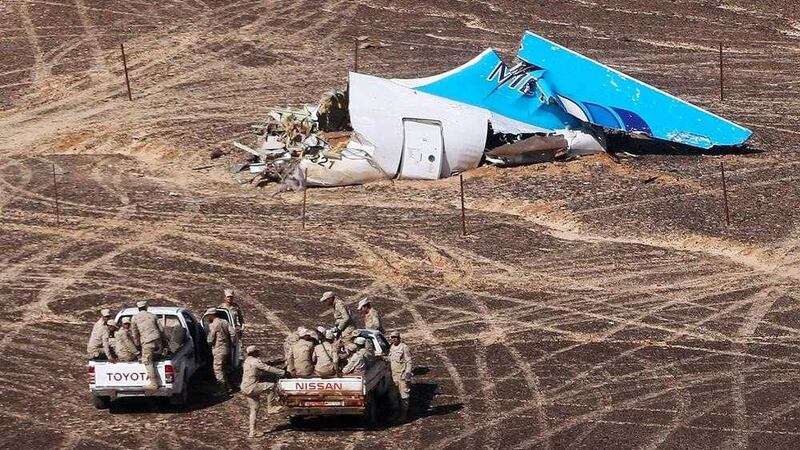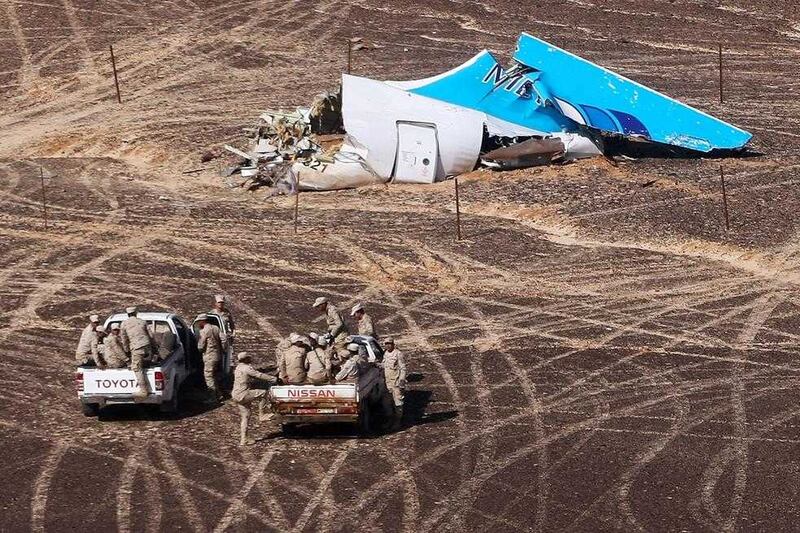Only an external impact could have caused a Russian plane to dive into the Egyptian desert, killing all 224 people on board, Metrojet airline officials said.
The firm's assertion has added to a series of confusing statements from investigators that left an unclear picture over what caused the plane to break up in mid-flight.
Alexander Smirnov, deputy general director of Metrojet, told a news conference in Moscow: "We rule out a technical fault of the plane or a pilot error. The only possible explanation could be an external impact on the aeroplane."
Russian aviation authorities were quick to criticise the company, calling its comments premature.
Mr Smirnov said the plane dropped 186mph in speed and about 5,000ft in altitude one minute before it crashed on Saturday.
But when pressed for more details about the type of impact and what could have caused it, Mr Smirnov insisted that he was not at liberty to discuss details because the investigation is ongoing.
He also did not explain whether he meant something had hit the plane, or that some external factor had caused the crash.
Mr Smirnov described the A321-200 as a reliable aircraft that would not fall into a spin even if the pilots made a grave error, because its automatic systems would correct crew mistakes.
The Airbus A321-200 was flying at 31,000ft over the Sinai Peninsula when it crashed just 23 minutes after taking off from the Egyptian Red Sea resort of Sharm el-Sheikh en route to St Petersburg.
Asked about Metrojet's claim of an external impact, the head of the Russian aviation agency, Alexander Neradko, said Metrojet's comments were "premature and not based on any real facts."
He urged aviation experts "to refrain from drawing conclusions" at this stage of the probe.
Mr Neradko, who spoke to Russian television in Cairo, insisted it would be possible to draw firm conclusions about the crash only after experts have studied the scattered fragments of the plane in Sinai and the content of its black box recorders.
He also mentioned that Egyptian authorities will not begin studying the black boxes until representatives of all the involved parties arrive. This includes not only Russia, Egypt and Airbus but also experts from France, Germany and Ireland, Mr Neradko said.
Viktor Yung, another deputy director general of Metrojet, said the crew did not send a distress call and they did not contact traffic controllers before the crash. His comments directly contradicted those of an Egyptian official, who said previously the pilot radioed that the plane was experiencing technical problems and he intended to try to land at the nearest airport.
An official at the Sharm el-Sheikh airport said he stands by the report that air traffic control there had told him they received a distress call from the plane.
The large area over which plane debris fragments have been found indicates the jet disintegrated while flying at high altitude, according to Mr Neradko on Sunday. On Monday, he once again refused to comment on any possible reason for the crash, citing the ongoing investigation.
When planes do break up in mid-air, experts say it is usually because of one of three factors: a catastrophic weather event, a mid-air collision or an external threat, such as a bomb or a missile.
A local affiliate of the extremist Islamic State group (IS) has claimed it brought down the aircraft, which crashed in the northern Sinai where the Egyptian military and security forces have battled militants for years.
Russian officials have dismissed that claim as not credible.
British military analyst Paul Beaver said he thought the crash was most likely caused by a bomb on board, saying he was certain that IS does not possess a missile system - such as the Russian Buk - that is capable of hitting a plane at such a high altitude.
"I'm pretty convinced that Isis doesn't have a 'double-digit' SAM (surface-to-air missile) that is necessary to go up as far as 31,000ft," he told The Associated Press, using an alternative acronym for the terror group.
"That's a very serious piece of equipment, and I don't think they have that sophistication."
He also said the Sinai desert is well-scrutinised by intelligence agencies, so a missile system would have been seen.
The flight recorders will provide key information, including the plane's airspeed and whether it was on autopilot.
Russian officials saw the black boxes found at the site and emergency situations minister Vladimir Puchkov said they are in a good condition.
A Russian cargo plane brought the first bodies of Russian victims killed in the crash to St Petersburg, where many of them are from.
The city is holding three days of mourning through until Tuesday.
The government plane carried in 130 bodies and 40 body parts that were whisked off to a city morgue and a crematorium, where Russian forensic experts immediately began working to try to identify the victims.
Family members of crash victims have already given DNA samples to speed the process.
At the crash site in Sinai, emergency workers and aviation experts from Russia and Egypt swept across the barren terrain, searching for more victims and examining the debris for more clues as to the cause of the crash.
Teams finished combing a 7.7-square mile area for bodies by the afternoon and expanded their search to a 11.6 square mile area. Mr Puchkov promised they will not rest until all the remains of the victims are found.
Another Russian government plane in the evening will take more remains to St Petersburg, he said.



